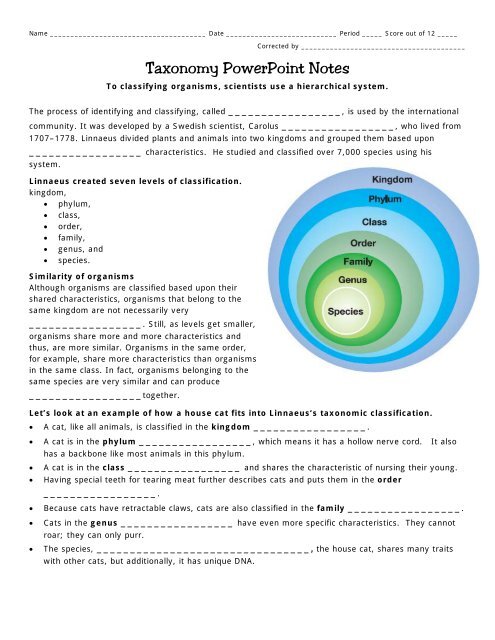Taxonomy PowerPoint Notes
Taxonomy PowerPoint Notes
Taxonomy PowerPoint Notes
Create successful ePaper yourself
Turn your PDF publications into a flip-book with our unique Google optimized e-Paper software.
Name ______________________________________ Date ___________________________ Period _____ Score out of 12 _____<br />
Corrected by ________________________________________<br />
<strong>Taxonomy</strong> <strong>PowerPoint</strong> <strong>Notes</strong><br />
To classifying organisms, scientists use a hierarchical system.<br />
The process of identifying and classifying, called _________________, is used by the international<br />
community. It was developed by a Swedish scientist, Carolus _________________, who lived from<br />
1707–1778. Linnaeus divided plants and animals into two kingdoms and grouped them based upon<br />
_________________ characteristics. He studied and classified over 7,000 species using his<br />
system.<br />
Linnaeus created seven levels of classification.<br />
kingdom,<br />
• phylum,<br />
• class,<br />
• order,<br />
• family,<br />
• genus, and<br />
• species.<br />
Similarity of organisms<br />
Although organisms are classified based upon their<br />
shared characteristics, organisms that belong to the<br />
same kingdom are not necessarily very<br />
_________________. Still, as levels get smaller,<br />
organisms share more and more characteristics and<br />
thus, are more similar. Organisms in the same order,<br />
for example, share more characteristics than organisms<br />
in the same class. In fact, organisms belonging to the<br />
same species are very similar and can produce<br />
_________________together.<br />
Let’s look at an example of how a house cat fits into Linnaeus‘s taxonomic classification.<br />
• A cat, like all animals, is classified in the kingdom _________________.<br />
• A cat is in the phylum _________________, which means it has a hollow nerve cord. It also<br />
has a backbone like most animals in this phylum.<br />
• A cat is in the class _________________ and shares the characteristic of nursing their young.<br />
• Having special teeth for tearing meat further describes cats and puts them in the order<br />
_________________.<br />
• Because cats have retractable claws, cats are also classified in the family _________________.<br />
• Cats in the genus _________________ have even more specific characteristics. They cannot<br />
roar; they can only purr.<br />
• The species, ________________________________, the house cat, shares many traits<br />
with other cats, but additionally, it has unique DNA.
How does a species get its scientific name<br />
The first _________________ to describe a new species gives it a scientific name. If the species<br />
belongs to an established genus, then the first part of the name is not new. If the organism cannot be<br />
placed into an _________________ genus, a new genus name must be given. There are many<br />
different sources for the species name such as appearance, behavior, habitat, location where it was found,<br />
or the name of the person who discovered it. When an organism is identified at the species level,<br />
scientists describe it using the species’ scientific name.<br />
A scientific name consists of two parts: its genus and its species.<br />
Genus names are usually _________________. Species names are usually<br />
_________________. A scientific name is incomplete without both the genus and species names,<br />
and all known living things have this two-part scientific name. Scientific names are usually in<br />
_________________ or _________________.<br />
The scientific name for cat, Felis domesticus, is Latin.<br />
Felis is Latin for “____________” and domesticus is Latin for “_________________.” The<br />
scientific name is usually printed in italics, with the genus capitalized. Because there are many different<br />
languages in the world, different common names could cause confusion among scientists from around the<br />
world. For example, a house cat is called a _________ in Mexico. Therefore, all scientists refer to each<br />
species by its scientific name.<br />
Do you know your scientific name<br />
It’s __________________________________!<br />
Can you come up with a mnemonic devices to remember the 7 levels of classification<br />
Here’s one: King Phillip Came Over For Good Spaghetti<br />
Write several below.<br />
_________________________________________________________________<br />
_________________________________________________________________<br />
_________________________________________________________________<br />
_________________________________________________________________
Use the following terms to complete the concept map below:<br />
• Phylum • Order<br />
• Classification • Species<br />
• Kingdom • Scientific name<br />
• Class • <strong>Taxonomy</strong><br />
• Family
















